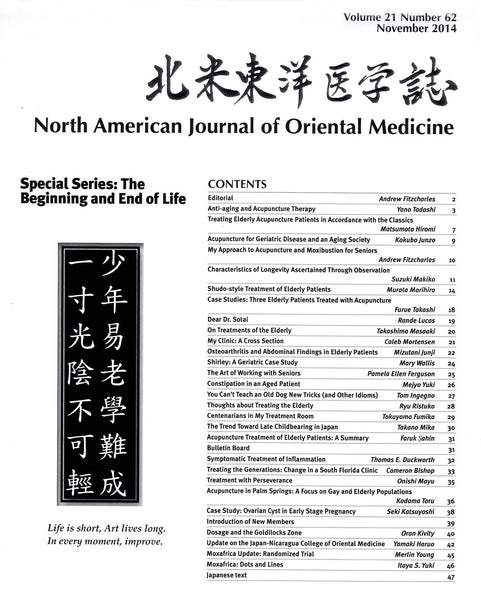Journal of Oriental Medicine "Shirley: A Geriatric Case Study"
Mary was published in the North American Journal of Oriental Medicine: Volume 21, Number 62 in November 2014, journal theme "Special Series: The Beginning and End of Life". The article is reprinted here:
Shirley: A Geriatric Case Study
by Mary Wallis
S. A., female, age 79, came into my office with both rotator cuffs damaged from an injury she had sustained while working three years prior. The muscle tears were great enough that range of motion above the shoulder was impossible. She suffered extreme pain that she said made her cry heavily every day. Life was a struggle, as she lived alone, and she alluded that it may not be worth living. At that time she reported that the doctors wouldn't do surgery due to her advanced age. Later I found out she had opted out of rotator cuff surgery as doctors couldn't assure her that it would make things better. Shirley had tried many allopathic therapies over the past three years to relieve the pain to no avail. "You're it kid! My last hope." I can't quantify how many of my patients have made similar comments to me over my career.
Shirley arrived at my doorstep in December of 2009. I had only been practicing professionally since January of 2007.This was a difficult challenge for such a novice meridian therapy practitioner. In fact, I encouraged her to see my teacher, Dr. Thomas Duckworth, L.Ac., D.K.M. But Shirley didn't want to drive the extra 16 miles to his clinic. So I said "I would do my best."
Her condition presented as a sunko ,"three time under," if I was correct in the pulse diagnosis. I still had difficulty understanding the influence of pain on the pulses. I treated her with #.02 Serin needles for ho and chose a #2 for sha. Te a te handwork finished the treatment as is my custom. She had some improvement symptomatically when I saw her after two days and appeared to have moved from a sunko to jingei condition. I again treated with needles and placed some press pins at select aze points. Four days transpired and she appeared to be a sunko condition again. She presented as a sunko again at the third treatment and was treated with needles again. But I began to consider that moxa may be more appropriate for her.
In the next treatment (now sunko "two time under", I used indirect moxa over gold magrain pellets that had been placed over active tsubo for the ho treatment. The dosage was seven so. Serin #3 needle was used for sha treatment. Her pulse quality changed significantly in addition to finding balance. Still it took another 15 treatments to find some sense of consistency in pulse condition and symptom relief. During that time she and I became frustrated. I know that as a practitioner I am to remain unattached to the outcome. This case got under my skin, so to speak. I had many dreams that offered new avenues to follow. I would try needles for ho again. Yet the better pulse quality always returned when using moxa and later handwork alone.
It was a struggle and I credit Shirley for staying with the process through so many treatments that had their ups and downs. And when she did feel better she would use that energy to do activities that were not in her best interest. Not one to be held back, she was still mowing her own lawn. One bout of relief and she decided to paint her kitchen. Another moment of pain subsiding and she decided to wash her car. We had many discussions about allowing the treatments to seat themselves and about asking others for assistance with some of the most difficult tasks.
On the 23rd treatment the miracle happened. She was free of the need for pain medication. She still had tightness. But she no longer needed the medicine and she was no longer crying each day, of her existence. It was then that we again had to have the talk about continued rest, as she was planning so many activities that might cause her to regress. Shirley followed direction and over the next several treatments we were able to put more days between our visits. There were appointments where she presented with such good pulses that I only performed ampuku (abdominal handwork) as the main treatment and te a te as the finish. She continued to improve. The swelling diminished from both shoulders. Range of motion did not improve. But Shirley was very happy with the results. She now sees me seasonally to maintain her freedom from pain and restored capacity for activity. At 84, she runs circles around me.
Due to this education that Shirley provided me. I now consistently use moxa as the treatment for most of my geriatric patients. Some of them do well with indirect moxa treatment and others need direct moxa. Often, when they are released to seasonal treatments, I am able to treat them successfully with only handwork.
Mary S. Wallis, L.Ac., NCCAOM Acupuncture Diplomate, L.M.T., C.N.M.T. owns Improved Performance Inc. in Florissant, MO, U.S.A. Mary became a massage therapist in 1989 and shortly after obtained Reiki training to level two. In 2002, she began her meridian therapy training under the tutelage of Thomas Duckworth, L.Ac., D.K.M. and in 2007 obtained her Missouri State License to practice acupuncture. Dr. Duckworth remains her teacher in post-graduate study. Mary (www.HealingStLouis.com) can be reached for comments at: MaryWallislmprovedHealing@gmail.com.


